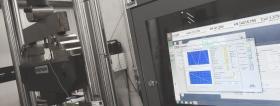Fracture toughness test

The crack behaviour of a given component prior to failure will determine the appropriate fracture toughness parameter:
- plane strain fracture toughness, KIc (linear elastic, LEFM)
- critical CTOD (elastic-plastic behaviour)
- critical J values (elastic-plastic behaviour)
In order to characterized the fracture behaviour as function of crack length of a material that exhibit stable crack extension, a resistance curves can be established:
- R-curve
- J-curve
Applications
- Off-shore fabrication (wind tower manufacturing, shipbuilding)
- Oil and gas industry (pipe welding)
- Cryogenic applications (iron-nickel alloys)
- LNG tanks (9% Nickel, Nickel base steel)
- Nuclear industry (Stainless steels)
- Aerospace industry (Titanium, Aluminium)
Test standards
- EN ISO 12135 - Determination of quasistatic fracture toughness
- EN ISO 15653 - Determination of quasistatic fracture toughness of welded joints
- BS 7448-1 - Fracture mechanics toughness tests of metallic materials
- BS 7448-2 - Fracture mechanics toughness tests of welds in metallic materials
- ASTM E 1290 - Crack-Tip Opening Displacement (CTOD)
- ASTM E 399 - Linear-Elastic Plane-Strain Fracture Toughness KIc of Metallic Materials
- ASTM E 1820 - Standard Test Method for Measurement of Fracture Toughness
- ASTM E 647 - Measurement of Fatigue Crack Growth Rates
If testing has to be performed according to any other test standard (e.g. BS, ISO, ASME, AWS, ASTM,...) listed above, please do not hesitate to contact us!
